Key takeaways:
- Accessibility in events is essential for fostering inclusivity, enhancing community-building, and ensuring all attendees feel valued and engaged.
- Incorporating sensory-friendly spaces and adaptive technologies, like real-time captioning and audio descriptions, significantly improves the experience for diverse audiences.
- Planning accessible events requires understanding and integrating the specific needs of attendees to create welcoming and enjoyable environments.
- Collaboration with diverse voices in the planning process leads to richer, more inclusive experiences for all participants.
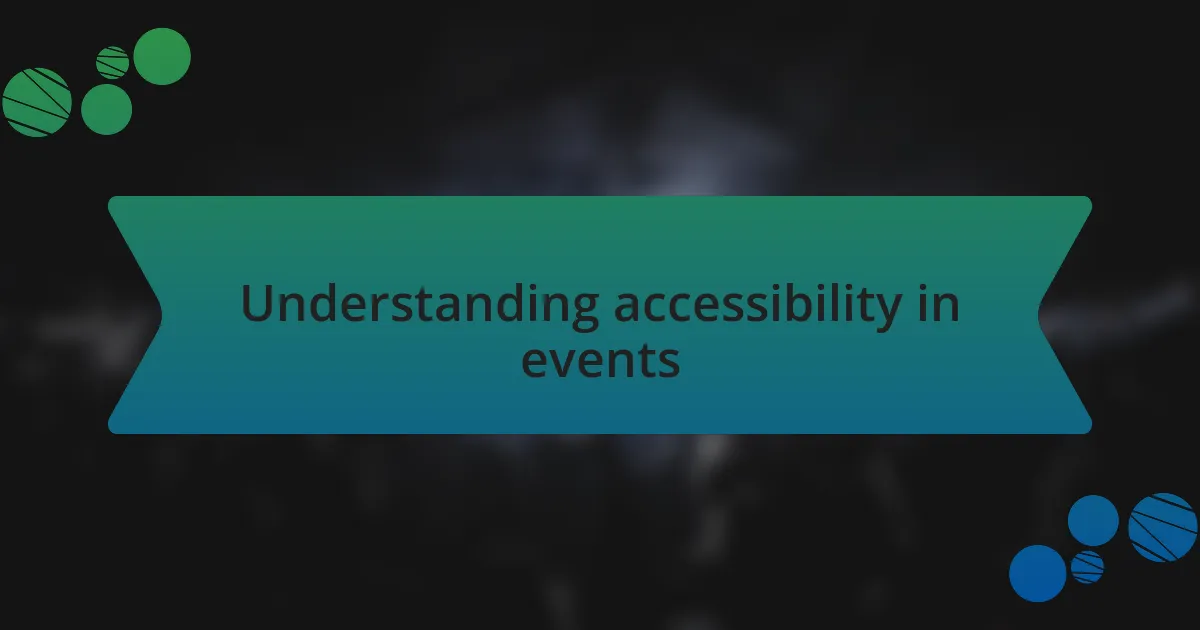
Understanding accessibility in events
Accessibility in events is not merely a checklist; it’s about creating an inclusive atmosphere where everyone feels welcome. I recall one event where a friend, who uses a wheelchair, faced barriers at the entrance that made it difficult for her to engage. This experience underscored the emotional weight of accessibility—something that can often be overlooked but is vital for genuine community-building.
Moreover, think about the sensory experiences that electronic music evokes. Some attendees may have sensitivities to loud sounds or flashing lights, and reflecting on this, I often wonder: how can we make this exhilarating experience enjoyable for everyone? Incorporating quieter spaces or providing sensory kits can transform an event from isolated moments to shared joy, allowing all attendees to fully immerse themselves in the celebration of music.
Each element of accessibility enriches the overall event, making it more memorable for everyone involved. I’ve learned that adaptability isn’t just a technical requirement; it’s about understanding people’s diverse needs. When attendees feel considered and valued, the collective experience of the event intensifies, creating lasting connections and unforgettable memories.
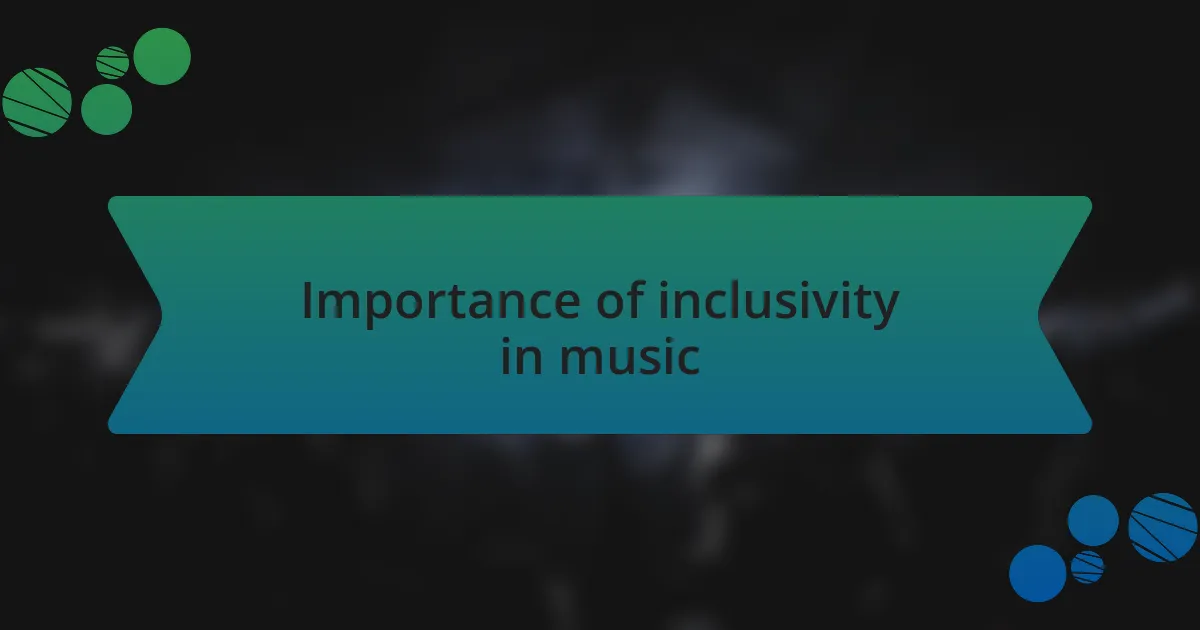
Importance of inclusivity in music
The importance of inclusivity in music cannot be overstated. I remember attending a festival where a deaf artist performed with a visual component—vibrant lights pulsing in sync with the beats. This experience profoundly impacted my understanding of music’s reach; it’s not just about sound, but how we perceive and connect through various senses. How can we deny anyone that emotional journey?
Beyond just the auditory experience, inclusivity in music also fosters community. I often think about how a friend who is part of the neurodiverse community expressed joy at an event designed with calming sound levels and areas for relaxation. This made me realize that creating a space for diverse audiences means enhancing the experience for everyone. What if more labels and artists could see the value in this approach?
Inclusivity in music creates a tapestry where different voices are heard and celebrated. I have seen firsthand the joy of collaboration between artists from various backgrounds; it’s like adding a new layer of richness to the music itself. Music, at its core, is about connection, and when we prioritize inclusivity, we create a space where everyone can contribute to and enjoy that harmony together.

Key considerations for accessible events
When planning accessible events, one key consideration is understanding the specific needs of diverse audiences. I recall an event where we provided seating arrangements for those with mobility challenges. It was encouraging to witness how something as simple as accessible seating made a world of difference for attendees who might otherwise feel left out. Have we thought enough about how small adjustments can create a welcoming environment?
Another crucial aspect is the incorporation of sensory-friendly spaces. At a recent festival, we designed quiet zones away from the main stages, allowing fans who may feel overwhelmed to recharge. This approach not only helped individuals manage their sensory input but also fostered a sense of community among those seeking refuge. How often do we overlook the importance of personal comfort in a communal setting?
Finally, communication access should never be an afterthought. At one of my own label’s events, we utilized sign language interpreters and provided information in multiple formats. The response from attendees was heartwarming; it showed that accessibility doesn’t just benefit a few but enriches the experience for everyone. Isn’t our goal to create memorable moments where every voice can be heard?
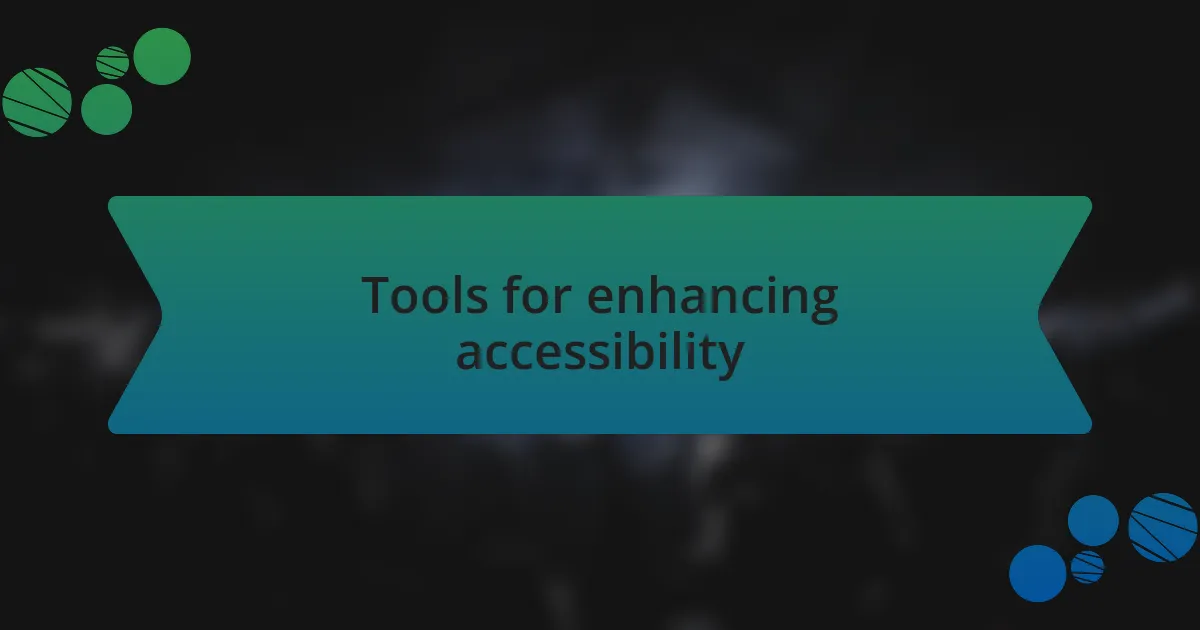
Tools for enhancing accessibility
When it comes to enhancing accessibility, I’ve found that technology can be a game-changer. For instance, I remember integrating audio description tools for visually impaired attendees during a live performance. The feedback was overwhelmingly positive; many shared how this allowed them to experience the music and visuals on a deeper level. Have we fully embraced the potential of technology to create inclusive experiences?
Another invaluable resource is the use of accessibility checklists in event planning. I often turn to these tools to ensure we tick all the right boxes—from ensuring that venues have appropriate ramps and elevators to verifying that our online platforms are screen reader-friendly. The sense of security that comes from knowing I’ve addressed these needs makes all the difference when preparing for an event. Are we proactive about accessibility, or are we waiting for issues to arise?
Finally, I’ve had success with real-time captioning services during our events. This has proven essential, especially for our audience members who are deaf or hard of hearing. One memorable occasion involved a lively panel discussion where the captions allowed for greater engagement from everyone in the room. This small addition transformed the atmosphere, reinforcing that communication truly is the bridge to connection. How often do we consider how such tools not only meet legal requirements but also enhance the audience experience overall?
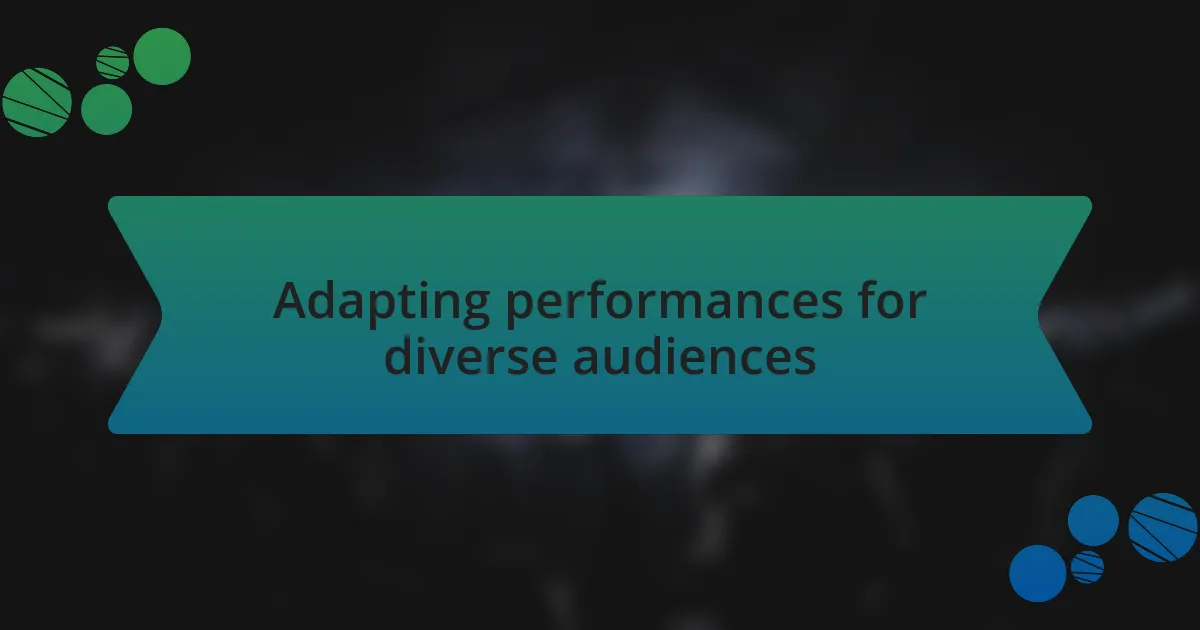
Adapting performances for diverse audiences
When I think about adapting performances for diverse audiences, one pivotal moment stands out: a show where we incorporated sign language interpreters. The visual rhythm of the performance took on a new dimension. Watching the interpreter convey the emotion and energy of the music was breathtaking. It made me realize that accessibility isn’t just about accommodating; it’s about enriching the entire experience for everyone.
In another instance, I facilitated a sensory-friendly environment during a festival. We adjusted lighting and sound levels, and even created quiet spaces where attendees could retreat if overwhelmed. The smiles and grateful nods I received from families showed me just how vital it is to consider every aspect of an event. Are we really recognizing the spectrum of needs within our audience?
I recently attended a performance where the organizer made an effort to include diverse seating options for various mobility needs. Seeing attendees comfortably enjoy the show, regardless of their physical limitations, deepened my appreciation for thoughtful planning. It reminds me that adapting performances is an ongoing journey; how can we continue to innovate and embrace all audience members in our future events?
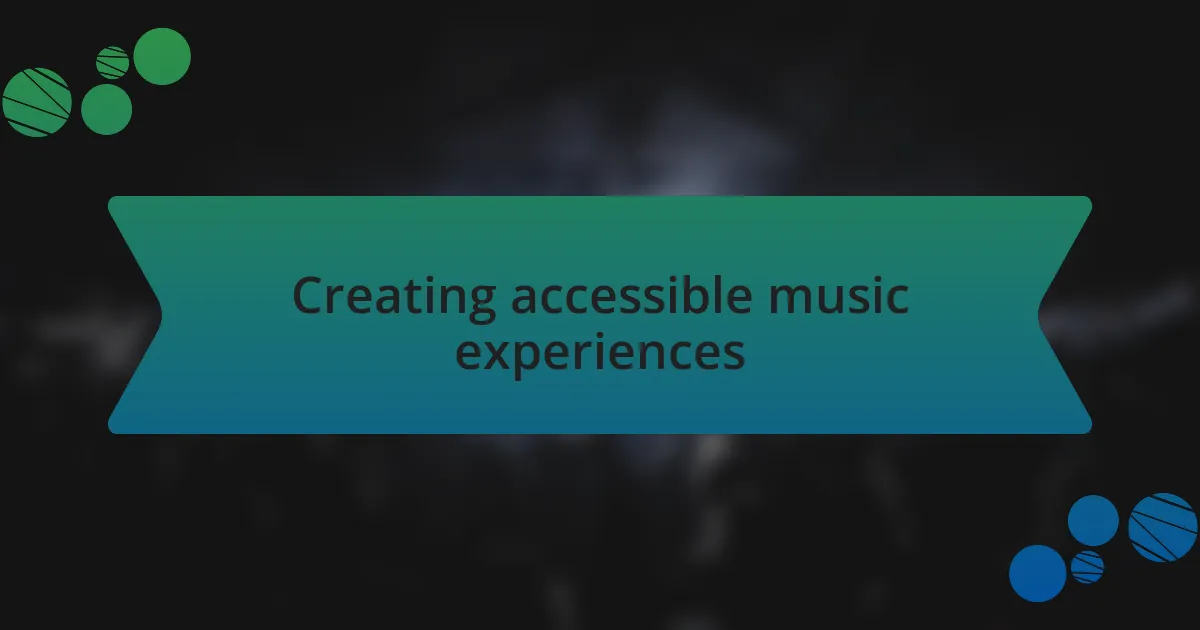
Creating accessible music experiences
Creating accessible music experiences goes beyond mere compliance; it’s about crafting moments that resonate with every listener. I recall a specific showcase where we offered audio descriptions for our visually impaired attendees. As a narrator guided the audience through the atmosphere and movements of the performance, I saw firsthand the wonder spreading across their faces. It was a profound reminder that music is a universal language, and that everyone deserves a chance to hear its nuances.
Technology has become an invaluable ally in creating more inclusive experiences. At one of our events, we introduced an app that allowed attendees to access real-time translations of lyrics and instruments. As people engaged with the app, I could see the spark of connection it initiated among individuals who may have felt isolated otherwise. It made me question: how often do we overlook these tools that can bridge gaps and foster community?
I can’t help but reflect on a moment during a collaborative concert where we incorporated live captioning on a large screen. The vibrancy of the performance grew as everyone sang along, encouraged by the words projected above. It struck me that these small adaptations can lead to monumental shifts in how we experience music together. Are we willing to embrace the creative possibilities that accessibility offers, not just as a necessity, but as an opportunity for innovation?
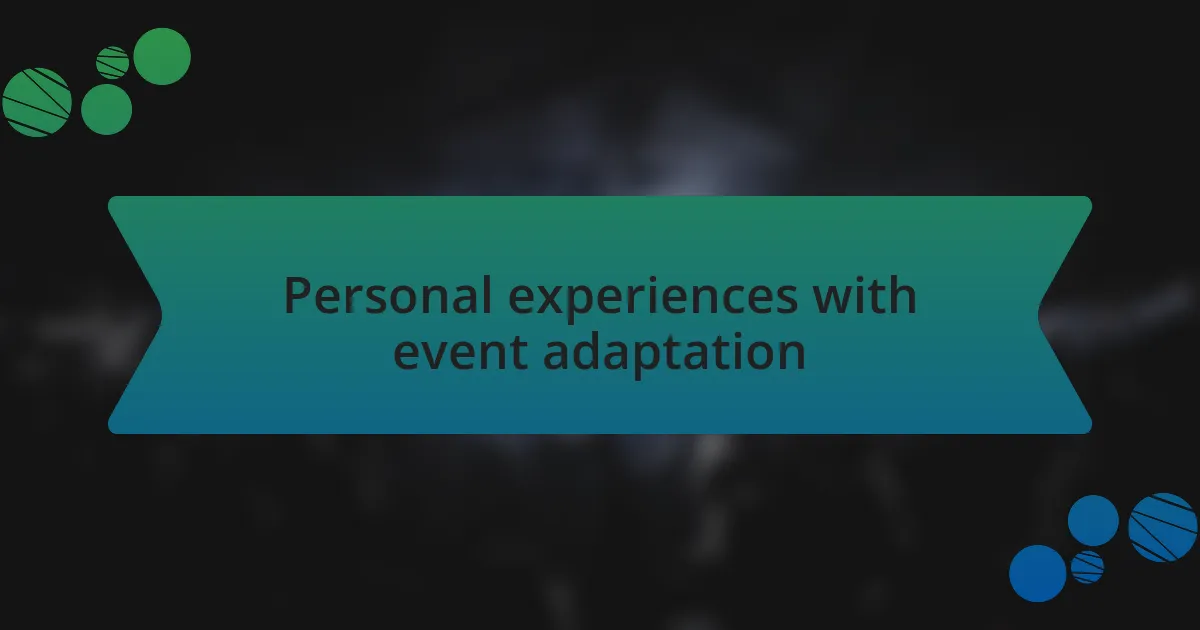
Personal experiences with event adaptation
Adapting events for accessibility has taught me invaluable lessons about empathy and inclusivity. During a festival I helped organize, we set up designated areas for individuals with mobility challenges. Watching attendees freely navigate the space, surrounded by music and laughter, deepened my appreciation for the impact of thoughtful design. Hasn’t everyone faced moments of feeling out of place? Creating an environment where everyone can thrive simply feels right.
In another instance, I witnessed the power of sensory-friendly spaces. We designated a quiet room where attendees could retreat if the noise became overwhelming. I remember a young girl who found solace there, her eyes lighting up as she discovered this calming escape. Seeing her return to the dance floor, re-energized and smiling, reminded me of the transformative nature of small adjustments. How often do we forget that inclusion allows for joy?
I also learned the importance of involving diverse voices in the planning process. Collaborating with artists and attendees with different experiences has led to more meaningful adaptations. I recall a conversation with a deaf artist who shared insights on how to make our music events resonate beyond sound. It opened my eyes to dimensions I’d never considered before. Isn’t it fascinating how each perspective can enrich the experience for all?